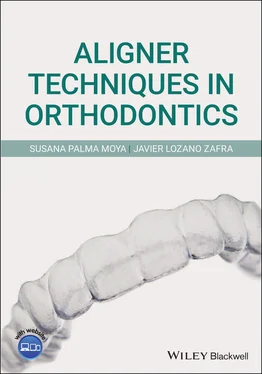563 567
564 568
565 569
566 570
567 571
568 572
569 573
570 574
571 575
Aligner Techniques in Orthodontics
Susana Palma Moya Javier Lozano Zafra

This edition first published 2021
© 2021 by John Wiley & Sons Ltd
All rights reserved. No part of this publication may be reproduced, stored in a retrieval system, or transmitted, in any form or by any means, electronic, mechanical, photocopying, recording or otherwise, except as permitted by law. Advice on how to obtain permission to reuse material from this title is available at http://www.wiley.com/go/permissions.
The right of Susana Palma Moya and Javier Lozano Zafra to be identified as the authors of this work has been asserted in accordance with law.
Registered Office(s) John Wiley & Sons, Inc., 111 River Street, Hoboken, NJ 07030, USA John Wiley & Sons Ltd, The Atrium, Southern Gate, Chichester, West Sussex, PO19 8SQ, UK
Editorial Office 9600 Garsington Road, Oxford, OX4 2DQ, UK
For details of our global editorial offices, customer services, and more information about Wiley products visit us at www.wiley.com.
Wiley also publishes its books in a variety of electronic formats and by print‐on‐demand. Some content that appears in standard print versions of this book may not be available in other formats.
Limit of Liability/Disclaimer of Warranty The contents of this work are intended to further general scientific research, understanding, and discussion only and are not intended and should not be relied upon as recommending or promoting scientific method, diagnosis, or treatment by physicians for any particular patient. In view of ongoing research, equipment modifications, changes in governmental regulations, and the constant flow of information relating to the use of medicines, equipment, and devices, the reader is urged to review and evaluate the information provided in the package insert or instructions for each medicine, equipment, or device for, among other things, any changes in the instructions or indication of usage and for added warnings and precautions. While the publisher and authors have used their best efforts in preparing this work, they make no representations or warranties with respect to the accuracy or completeness of the contents of this work and specifically disclaim all warranties, including without limitation any implied warranties of merchantability or fitness for a particular purpose. No warranty may be created or extended by sales representatives, written sales materials or promotional statements for this work. The fact that an organization, website, or product is referred to in this work as a citation and/or potential source of further information does not mean that the publisher and authors endorse the information or services the organization, website, or product may provide or recommendations it may make. This work is sold with the understanding that the publisher is not engaged in rendering professional services. The advice and strategies contained herein may not be suitable for your situation. You should consult with a specialist where appropriate. Further, readers should be aware that websites listed in this work may have changed or disappeared between when this work was written and when it is read. Neither the publisher nor authors shall be liable for any loss of profit or any other commercial damages, including but not limited to special, incidental, consequential, or other damages.
Library of Congress Cataloging‐in‐Publication Data
Names: Lozano Zafra, Javier, author. | Palma Moya, Susana, author.
Title: Aligner techniques in orthodontics / Javier Lozano Zafra, Dr Susana Palma Moya.
Description: Hoboken, NJ : Wiley‐Blackwell, 2020.
Identifiers: LCCN 2020024180 (print) | LCCN 2020024181 (ebook) | ISBN 9781119607229 (paperback) | ISBN 9781119607212 (adobe pdf) | ISBN 9781119607236 (epub)
Subjects: MESH: Malocclusion–therapy | Orthodontics, Corrective–methods | Orthodontic Appliance Design–methods
Classification: LCC RK523 (print) | LCC RK523 (ebook) | NLM WU 440 | DDC 617.6/43–dc23
LC record available at https://lccn.loc.gov/2020024180LC ebook record available at https://lccn.loc.gov/2020024181
Cover Design: Wiley
Cover Image: Courtesy of Javier Lozano Zafra
I started to work with aligners in 2001 and immediatly I realized that they had a huge potential. It was easy for me to get familiar with the whole idea because I used to work with dental positioners at that time. In contrast, most of my colleagues were quite skeptical and did not consider aligners as a real orthodontic system.
Reviewing the literature we can see how the possibilities of the aligners have increased over the years. In 2001, there were limited tools available to solve mild crowded Class I malocclusions; however, several years after, we started to speak about extraction cases, Class II malocclusions, and open bites, which were treated more successfully each time. This situation was due to two factors: on the one hand, the continuous feedback the manufacturers use to make constant improvements, and on the other hand, the tremendous effort by many orthdontists who have been triyng to understand and explain what we call “ the plastic biomechanics .” Therefore, the perception of using the aligners as an effective orthodontic method is improving due to the irrefutable fact that the results are getting better and better and, in many cases, they overtake the outcomes achieved by conventional orthodontics.
We are only beginning to understand how the aligners move teeth, and the learning curve is slower than we thought. Those are the reasons why their effectiveness is indisputably attached to academic training and experience. The professionals with greater knowledge and greater number of treated cases will achieve better results. This is no surprise as this is what happens when a new technique is introduced.
For all these reasons, as professionals, we are the ones who still establish our treatment goals. Aesthetics and the patient’s comfort should not conflict with the quality of the treatment results. This means that in quite a few situations, we need to use auxiliary techniques to complement the aligners deficiencies. It also means on the part of the practitioner a greater effort and dedication than usual to the occlusal and functional treatment finishing, and especially to training. I understand that leaving the comfort zone is not easy for those who have been treating patients the same way their whole life . This is where Dr. Palma and Dr. Lozano are absolutely exactly correct. This book fills a gap in our interpretation of the orthodontic movement with aligners. It offers a great number of essential keys to the understanding of the aligners biomechanics. It is the right publication at the right moment, with guides to treat different malocclusions with confidence, predictability, and quality. Following their solid biomechanics knowledge and experience‐based advice, the reader will be introduced to the treatment of more and more difficult cases, always keeping the traditional occlusal standards.
The book covers all the different malocclusions from the easiest mild crowding cases to the complex pre‐prosthetic treatments. It is written like an atlas, with specific cases fully explained step by step. The reader will also find an innovative and attractive video format of each treatment. For all these reasons, this book is a wonderful and easy tool for references suitable for beginners, but also for orthodontists well trained in aligners. Moreover, for the skeptical ones, the book, at least, will peak their curiosity. Is it really possible to perform a good quality orthodontics with aligners? This book will provide answers, and without doubt, many arguments for discussion.
Читать дальше













